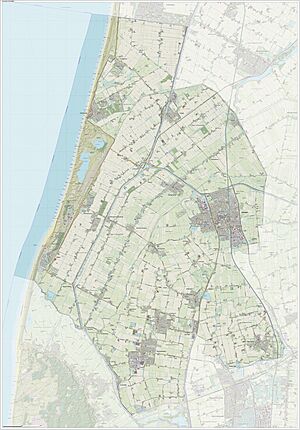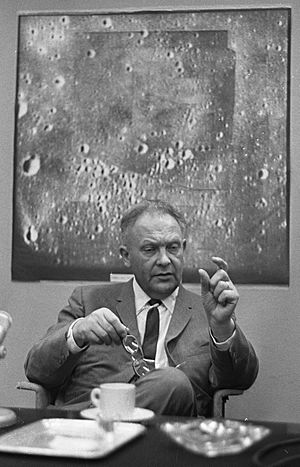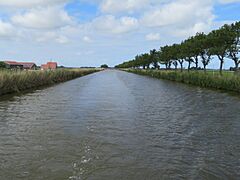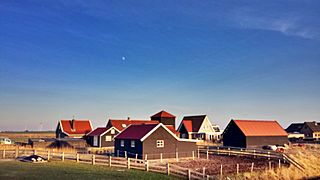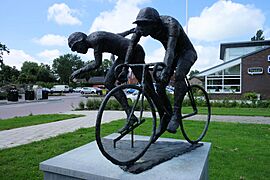Schagen facts for kids
Quick facts for kids
Schagen
|
|||
|---|---|---|---|
|
City and municipality
|
|||
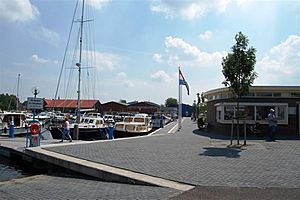
Marina in Schagen
|
|||
|
|||
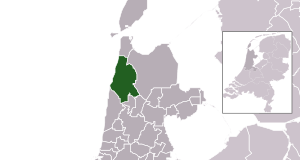
Location in North Holland
|
|||
| Country | Netherlands | ||
| Province | North Holland | ||
| Government | |||
| • Body | Municipal council | ||
| Area | |||
| • Total | 187.28 km2 (72.31 sq mi) | ||
| • Land | 167.91 km2 (64.83 sq mi) | ||
| • Water | 19.37 km2 (7.48 sq mi) | ||
| Elevation | 0 m (0 ft) | ||
| Population
(May 2014)
|
|||
| • Total | 46,160 | ||
| • Density | 275/km2 (710/sq mi) | ||
| Demonym(s) | Schagenaar, Schager | ||
| Time zone | UTC+1 (CET) | ||
| • Summer (DST) | UTC+2 (CEST) | ||
| Postcode |
1738–1759
|
||
| Area code | 0224, 0226 | ||
Schagen (Dutch pronunciation: [ˈsxaːɣə(n)]) is a city and municipality in the northwestern part of the Netherlands. It is located between two larger cities, Alkmaar and Den Helder. Schagen is part of the West Friesland region and the province of North Holland. It became a city in 1415, which meant it gained special rights.
In 2013, Schagen joined with two nearby municipalities, Zijpe and Harenkarspel. They all became one new municipality, still called Schagen. The main government building, the town hall, is in the central town of Schagen. The area has a population of 46,160 people and covers about 187.28 km2 (72.31 sq mi).
Contents
History of Schagen
Early Beginnings (10th-15th Century)
Schagen is a very old place, first mentioned in writings around the year 975. One old record showed that 43 people lived there. It was also called "Scagha" in documents from about 989. At that time, Schagen was known for its "terps," which are artificial hills built by people to live on, above the water.
The name "Scagha" might mean "elevated point," referring to its higher ground compared to the surrounding water. For a while, the sea was very close to Schagen. When the sea moved back in the late 1200s, the towns in the area started to grow. The land around Schagen was very good for farming, which helped it become and stay the most important town in the region.
In 1415, William VI, a powerful ruler, gave Schagen its city rights. This meant the town could govern itself more and hold markets. Later, in 1427, Philip the Good of Burgundy gave Schagen to his uncle, William of Bronckhorst. Schagen became a "fief," which was like a special land grant. This gave William of Bronckhorst control over Schagen and some smaller towns nearby.
William built a castle in Schagen where he lived starting in 1440. In 1460, the main church of Schagen, named after St. Christopher, was officially opened. Just three years later, in 1463, Schagen got the right to hold a cattle market. This made it an important trading center for a wide area.
Growth and Markets (16th-19th Century)
From 1603, an annual horse market was held in Schagen. This was allowed by the government of Holland and Westfriesland. During the early Golden Age of the Netherlands, Schagen did not grow as much as other big cities like Alkmaar or Hoorn.
However, later in the Golden Age, Schagen did benefit from the country's wealth, but not as much as those other cities. Even after the Golden Age, its growth was slow. In the 1800s, when the land around Schagen was drained and made usable, the town's economy grew again. The cattle market was especially important. When a railroad line opened in 1865, connecting Schagen to Alkmaar and Den Helder, the markets and local businesses really boomed. At this time, Schagen had about 2060 people.
Modern Times (20th-21st Century)
In the 1900s, Schagen's wealth slowly decreased, especially after Second World War. The farming industry faced a big decline. But because Schagen had more than just farming, it didn't suffer as much as other small towns nearby. Around 1960, Schagen started to grow again, though its population was still under 5,000.
The 1970s brought a big growth period for Schagen. In the early 1990s, growth slowed down, but Schagen remained strong compared to its neighbors.
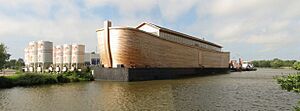
From 2005 to 2007, a man named Johan Huibers, who lived in Schagen, built a huge ship. It was made to look like the Noah's Ark from the Bible. This ship, called Johan's Ark, opened to visitors in April 2007. It was later moved to different port cities in the Netherlands.
Getting Around Schagen
Schagen has a railway station where "intercity" trains stop. These trains connect Schagen well with Den Helder to the north and Alkmaar and Amsterdam to the south. All trains going south pass through Amsterdam Centraal. From there, they continue to places like Utrecht Centraal, Eindhoven, Maastricht, Arnhem, and Nijmegen. A train ride to Amsterdam takes about 51 minutes to Sloterdijk or 57 minutes to Centraal Station.
The railway station is also the main place for local and regional bus services in Schagen. 2017, three of the five working "vlotbruggen" (which means "float bridges") in the Netherlands are located in the Schagen area. You can find them at Burgervlotbrug, Sint Maartensvlotbrug, and 't Zand. These bridges float on the water to let boats pass.
Famous People from Schagen
Many interesting people have come from Schagen or the surrounding area:
- Adriaen van Cronenburg (1525 in Schagen – after 1604) was a painter, mostly known for his portraits.
- Jan van Noordt (1623/24 in Schagen – after 1676) was a famous painter during the Dutch Golden Age.
- Simon Berman (1861 in Landsmeer – 1934) served as the Mayor of Schagen from 1894 to 1900.
- Gerard Kuiper (1905 in Tuitjenhorn – 1973) was a Dutch-American astronomer. A part of our solar system, the Kuiper belt, is named after him!
- Joop Klant (1915 in Warmenhuizen – 1994) was a Dutch economist, writer, and professor.
- Ben Essing (1935 in Dirkshorn – 1994) was a Dutch impresario, someone who organizes concerts and shows.
- Cees Geel (born 1965 in Schagen) is a Dutch actor who has appeared on television, radio, and in films.
- Bianca Krijgsman (born 1968 in Oudesluis) is a comedian and Dutch actress.
- Daniella van Graas (born 1975 in Tuitjenhorn) is a Dutch fashion model and actress.
- Femke Meines (born 2000 in Tuitjenhorn) is a Dutch singer and actress.
Sport Stars
- Rein Boomsma (1879 in Schagen – 1943 in Neuengamme concentration camp) was a Dutch footballer.
- Richard Rozendaal (born 1972 in Warmenhuizen) is a track cyclist who competed in the 1996 Summer Olympics.
- Ruben Houkes (born 1979 in Schagen) is a Dutch judoka who won a bronze medal at the 2008 Summer Olympics.
- Celeste Plak (born 1995 in Tuitjenhorn) is a Dutch volleyball player.
- Pleuni Cornelisse (born 1999 in Schagen) is a Dutch judoka.
Images for kids
See also
 In Spanish: Schagen para niños
In Spanish: Schagen para niños




